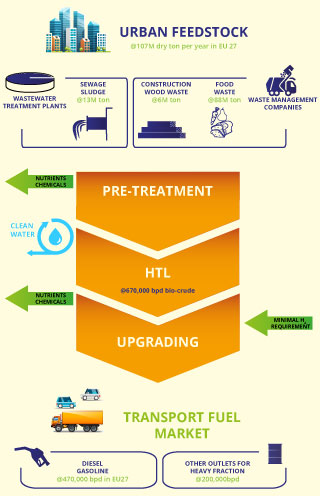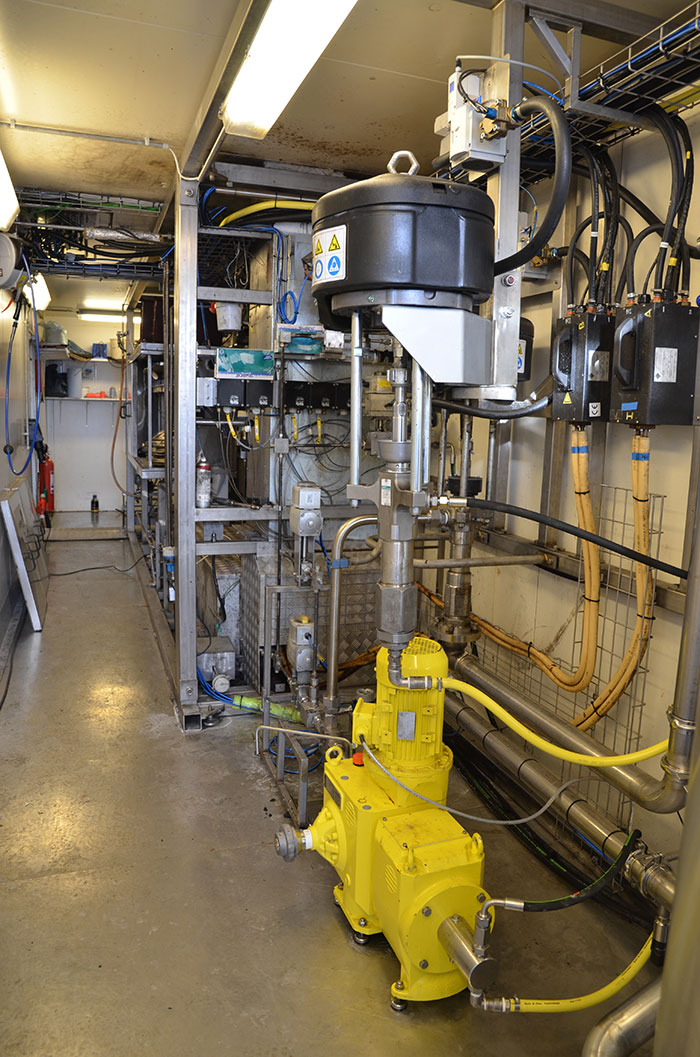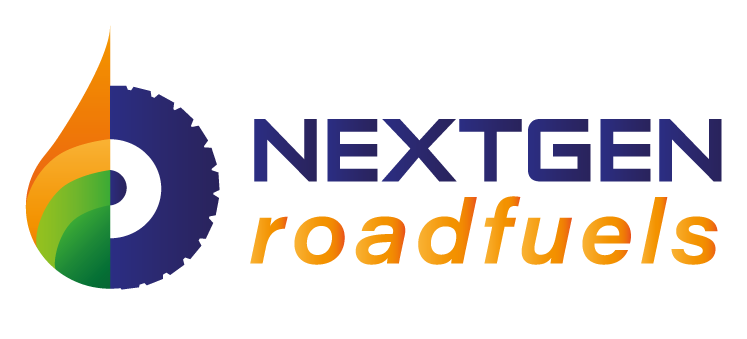The Process
The Process
HTL processing, combined with appropriate pre- and post-treatment is the single most effective technology pathway to valorize the combination of sewage sludge, food waste and construction wood waste and to convert the carbon content of these feedstock into drop-in fuels.
The process developed by NextGenRoadFuels is characterized by extreme resource flexibility and efficiency.
Hover on the green arrows to find out more
Feedstocks
The figure indicates the pathways from urban feedstock to transport fuels. Sewage sludge is increasing annually in the EU and is expected to reach 13 million dry tons by 2020. The innovation of NexGenRoadFuels is to use a single HTL plant to co-process a mixture of sewage sludge together with other abundant types of urban waste such as food waste and construction wood waste, thus providing a robust and viable approach to scale up production, instead of processing each single feedstock.
Pre-Treatment
Proteins and other nitrogen-containing compounds are part of the organic fraction of the feedstock. These are detrimental to fuel production and must be removed prior to HTL, phosphorous, ammonia and other inorganic compounds must also be removed. In NextGenRoadFuels, processes and methodologies based on enzymatic as well as chemical treatment will be developed for recovering and further valorisation of both proteins and phosphorous from organic waste feedstock, adopting a circular economy approach.
HTL bio-crude oil
Hydrothermal Liquefaction (HTL) can be used to process all types of organic materials. HTL oil is typically a complex mixture of several hundreds of organic compounds. Its exact chemical composition and physical properties can vary substantially depending primarily on the type of feedstock, but also on the reaction conditions (temperature, pressure, reaction time etc.).
It is a relatively viscous fluid, which normally contains residual moisture and oxygen, though significantly less than the original feedstock.
The pre-treatment and the post-treatment phases are extremely important to guarantee both a high-performance HTL process and high-quality end products meeting current road transport fuel specifications.
Upgrading
A novel modular upgrading concept allows combinations of electrocatalytic and thermal catalytic upgrading of the high-quality HTL bio-crude oil into drop-in fuels an. Innovative synthetized catalysts will be designed and tested.
End products
Sustainable, synthetic drop-in fuels will be separated by distillation. A main advantage of drop-in fuels is the ability to go directly to high blend ratios without the need of establishing a new fuel infrastructure. This saves both time and infrastructure investments and repurposes already existing hydrocarbon infrastructure. In NextGenRoadFuels the primary drop-in fuels will be compliant with gasoline and diesel market specifications. Besides fuels, more complex and larger hydrocarbons will be obtained from HTL Bio-crude. These may have applications in several markets, such as those related to marine fuels or lubrication products, which will also be explored in NextGenRoadFuels.
HTL processing, combined with appropriate pre- and post-treatment is the single most effective technology pathway to valorize the combination of sewage sludge, food waste and construction wood waste and to convert the carbon content of these feedstock into drop-in fuels.
The process developed by NextGenRoadFuels is characterized by extreme resource flexibility and efficiency.

Feedstock
The figure indicates the pathways from urban feedstock to transport fuels. Sewagle sludge is increasing annually in the EU and is expected to reach 13 million dry tons by 2020. The innovation of NexGenRoadFuels is to use a single HTL plant to co-process a mixture of sewage sludge together with other abundant types of urban waste such as food waste and construction wood waste, thus providing a robust and viable approach to scale up production, instead of processing each single feedstock.
Pre-Treatment
Proteins and other nitrogen-containing compounds are part of the organic fraction of the feedstock. These are detrimental to fuel production and must be removed prior to HTL, phosphorous, ammonia and other inorganic compounds must also be removed. In NextGenRoadFuels, processes and methodologies based on enzymatic as well as chemical treatment will be developed for recovering and further valorisation of both proteins and phosphorous from organic waste feedstock, adopting a circular economy approach.
HTL bio-crude oil
Hydrothermal Liquefaction (HTL) can be used to process all types of organic materials. HTL oil is typically a complex mixture of several hundreds of organic compounds. Its exact chemical composition and physical properties can vary substantially depending primarily on the type of feedstock, but also on the reaction conditions (temperature, pressure, use of solvent, reaction time etc.). It is usually relatively viscous and corrosive, with high moisture and oxygen content. The pre-treatment and the post-treatment phases are extremely important to guarantee both a high-performance HTL process and high-quality end products meeting current road transport fuel specifications.
Upgrading
A novel modular upgrading concept allows combinations of electrocatalytic and thermal catalytic upgrading of the high-quality HTL bio-crude oil into drop-in fuels an. Innovative synthetized catalysts will be designed and tested.
End products
Sustainable, synthetic drop-in fuels will be separated by distillation. A main advantage of drop-in fuels is the ability to go directly to high blend ratios without the need of establishing a new fuel infrastructure. This saves both time and infrastructure investments and repurposes already existing hydrocarbon infrastructure. In NextGenRoadFuels the primary drop-in fuels will be compliant with gasoline and diesel market specifications. Besides fuels, more complex and larger hydrocarbons will be obtained from HTL Bio-crude. These may have applications in several markets, such as those related to marine fuels or lubrication products, which will also be explored in NextGenRoadFuels.
Below: The HTL part of the continuous bench scale 1 HTL plant, at Aalborg University (DK)
Credits: Muhammad Salman Haider, Aalborg University (DK)

